Jul 22, 2020
STUDIO VISIT: Jeffrey Meris on breath, environmental knowledge, and placelessness
During my studio visit with Jeffrey Meris in February 2020, we talked about ephemerality, the breath, knowledge we’ve absorbed from the environment, water, and ancestors, and his relationship to time and place. Before our visit, Jeffrey asked me to bring a teacup to trade.
JEFFREY: Several years ago, I made 40 teacups and 40 saucers. I want to reimagine this project in New Haven, especially how we use the word “community.” I started this project in 2013, the 40th anniversary of the Bahamas’ independence from British. I wasn’t born in the Bahamas, and the discourse is often around where you are born. There’s a lot of loopholes in my family. My mom was born in Abaco, one of the islands decimated by the hurricane, but born in the Bahamas pre-1973, when the Bahamas was still a British colony. Haiti at the time was a dictatorship. And the dictator demanded all Haitians to return to Haiti or else you’d face persecution when you do return. So my grandmother returned to Haiti with my mom. Because my mom was born in the Bahamas before it became independent, she was a Bahamian citizen. And even though I was born in Haiti, outside the Bahamas, I became a Bahamian citizen. So it becomes this thing where your citizenship is given via loopholes, and so what does it mean for me to be “from” the Bahamas?
So I invited folks to come sit and have tea with me and we’d talk about those questions. I can have tea with someone who sees the world completely differently. And you’re the first person I’m sitting with.
MICHELLE: I feel so honored! What kind of tea is this?
J: It’s herbal. I also want to drink less coffee. [laughs]
[We sit and Jeffrey pours an incredible floral-herbal tea.]
M: I love this question: how do we actually meet each other? Not just symbolically, but to really meet and see each other. I didn’t know that story of your birthplace and your relationship to citizenship.
J: Yeah, it’s really important to how I think about how I exist spatially and socially, in space and place, to The Bahamas and to Haiti–as much as I’d like to think I’m not implicated in this story of nation, those two places mean something.
M: There’s also this ambiguity of how citizenship is assigned, and birthplace, and when you’re actually entering the world, you don’t have a choice as to where you are born. [I pull out the teabag from my cup]
J: I don’t like it too steeped, too.
M: Yeah, my friend likes to keep it in there–
J: –and it gets all bitter!
M: Exactly!
J: And how random things like geography can determine the way we walk in the world. The way we move, and my relationship to land.
M: Yeah I’ve definitely had distinct moments in my life where I’ve thought, if I was born in Vietnam, if the war hadn’t happened… there’s this passage in The Sympathizer, “…if we forgot our resentment, if we forgot revenge, if we all acknowledged we were puppets in someone else’s play, if we had not fought a war against each other,” like, would we be more intact?
J: Yeah, ideally what I’m trying to understand, is “Where’s my place in this?” Sometimes I think in an ideal world, I’d like to be placeless…in a lot of these circumstances, it’s understanding your subjectivity…and that’s just a broad umbrella.
M: YES I feel you, placelessness…when do you feel closest to understanding your subjectivity, in your own seeing?
J: That’s a really good question. This is the sucky part but I feel a lot of it is unfortunately a series of wakeup calls. The integrity of the mirror is not reliable. And when I think about representation…the irony is that we’re trying to dismantle and rethink this idea of nation and territory, and now your actual body is representative of this uncontainable idea of place and belonging and whether you even relate to that.
I have big hesitations around representation, I have one body, and the Bahamas is 400,000 people. I’m interested in this place that’s unnameable, or a place that’s not grounded in homogeneous spaces of hegemony, I want to push against it, I don’t want to be contained in it.
It’s such a foreign concept to me…
M: Totally. In writing, I hit a point when I’m leaning on tropes of Vietnameseness or Vietnam, I’m leaning on Vietnameseness in its abstraction or essentialism, or my elders’ stories, or the Vietnam War–it’s never not related, yes we come from our land, it’s in our bodies, we can’t escape our relationship to land, ever, but is there some bigger thing our bodies signify? Earlier in the year you talked about transcendence…when I think of transcendence I think of an out-of-body experience.
J: Man! That’s the thing. After a while, it almost becomes genetic. The way we understand this America working on us, vs. the way I would be formed in the Bahamas. No matter how much push around “-ness” or being tied to a specific region or locale, there’s something in place that we always fall back to, this form of knowledge contained within the body, and the body responds to those environments. The trouble arises when we try to name that thing that doesn’t–that can’t–
M: That resists language. Our relationship to land that is known but elusive, hard to articulate, hard to attach ourselves to it as an identifier in every space we move through. We’re never not related to a land, or land.
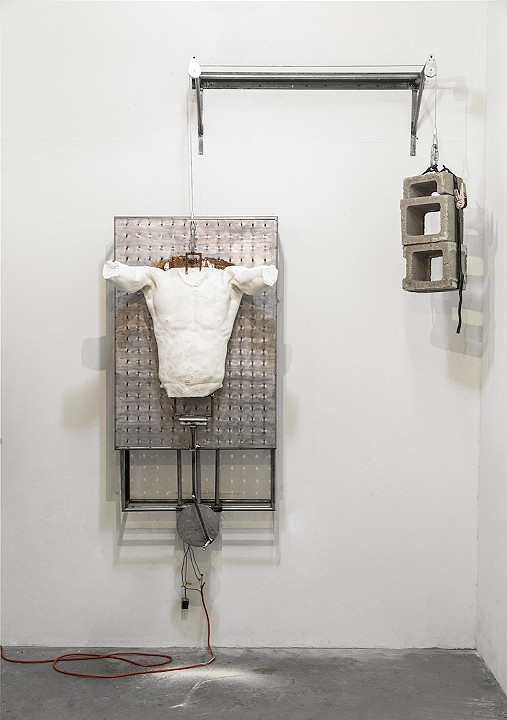
J: That’s the more interesting critical conversation, and often missing in these conversations about these formal markers of geopolitics. I’ve lived in this space therefore this is the relationship, or, this is my understanding of land and the things it produces. The Bahamas is surrounded by the sea, which means things oxidize at a much faster rate. It is a coincidence therefore that my work thinks about this process of oxidization and decay? I don’t know.
M: What I’m sensing is that the knowledge is ingrown, subterranean, versus a surface naming via terms constricted by geopolitical definitions (of citizenship, national identity, birthplace) issued by governments and nations. What’s articulated materially is just what is already in you.
J: Right. I think a lot of it too comes from having grown up in that space. And we have this festival called Junkanoo that was how I was introduced to art-making–though it’s not considered “art” since it’s such a folk tradition. This is still a language.
M: Yes. What are your working on now?
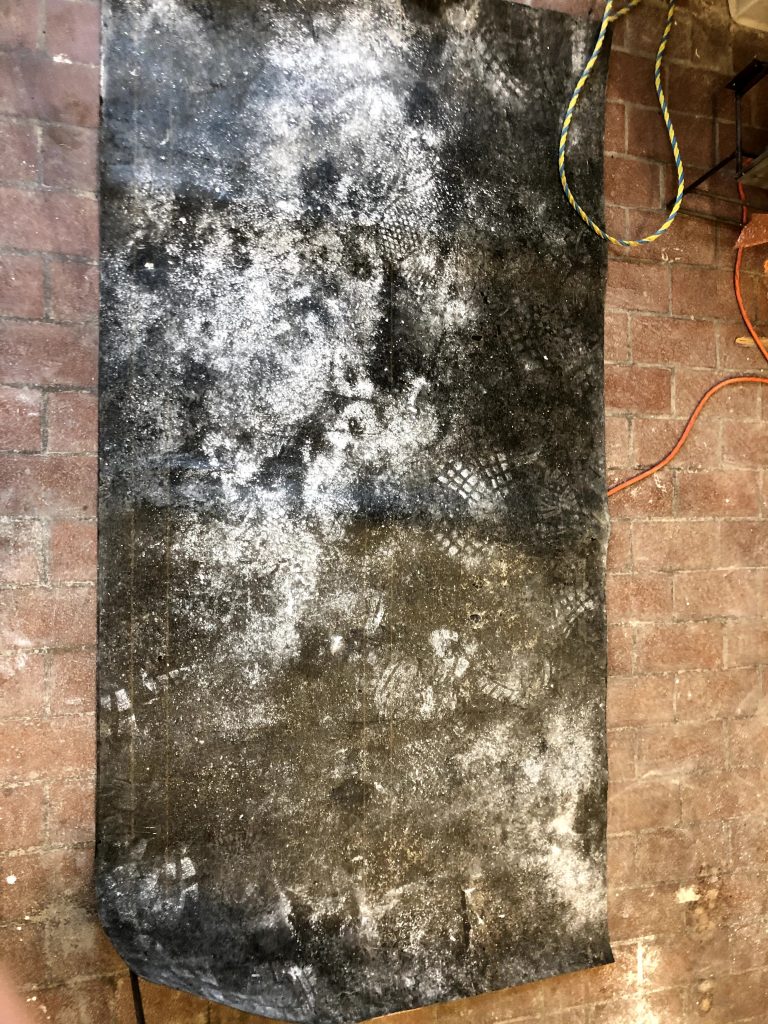
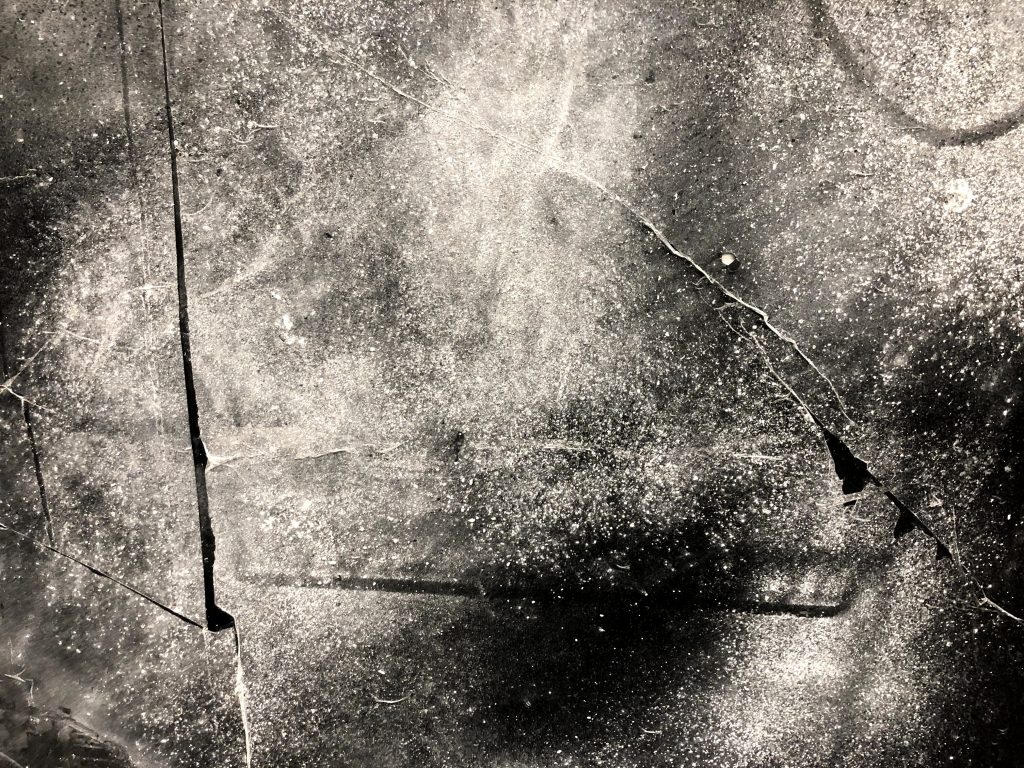
J: I’m working on these drawings, derivative of these sculptures, which I’m using these kinetic machines. The tape sticks to the paper for 24 hours. For 24 hours, the adhesive front side is activated. These sculptures are making these drawings, these indexical photographs, it’s a drawing language, these receipts. I’m thinking of ways of abstracting them. Wherever there’s gaps of pure black, that’s where the tape misregisters–so I’m interested in that misregistering as well.
I’ve been reading Native Son, and I’m thinking about doing a skywriting of “BIGGER LIVES”…even though I work in sculpture, I’m interested in these other materials (like skywriting) that are so ephemeral. I constantly struggle with my relationship to time, so these sculptures have a life and a death, too.
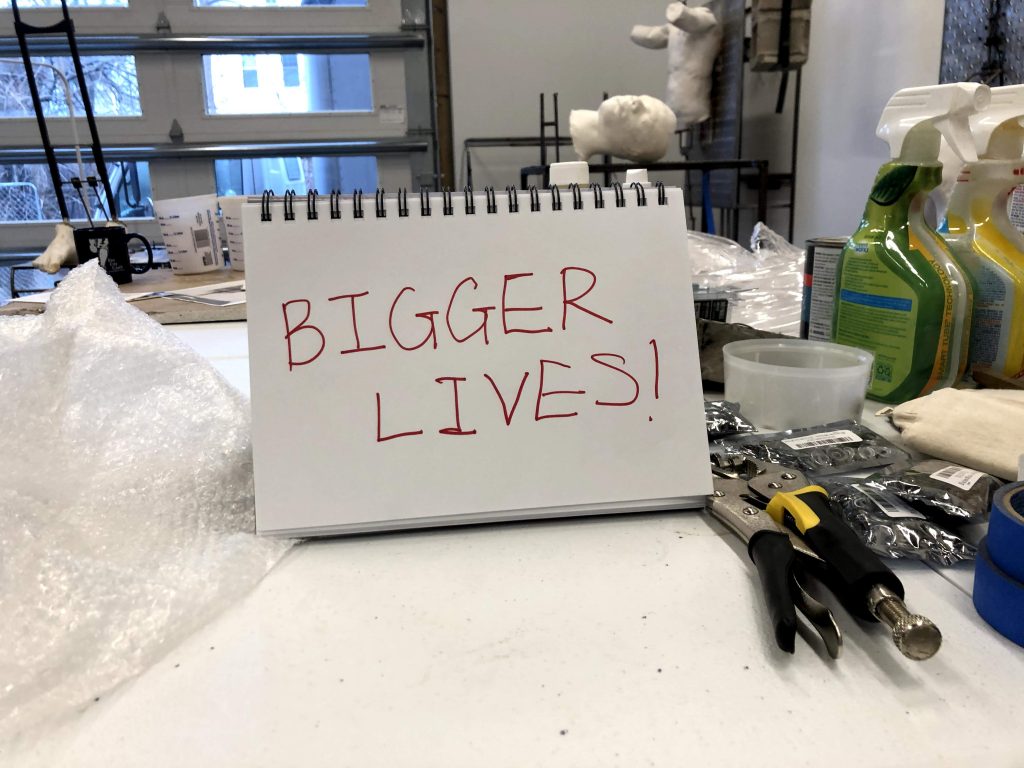
M: Yeah. Even though there’s a solidity to sculpture, and a kind of permanence because this is a plaster cast, and so you can replicate it, these are self-destructing.
J: Right. I’m also working on these, and [NXTHVN Apprentice] Emae is helping me button these together. I’ve been saving these sculptures in storage for quite some time, maybe 5 months, and while they were in storage. Those brown stains, it’s actually a rust stain. Because there wasn’t climate control, they got all rusted, and turned this really grimy brown, and became kind of a sculpture on top of a sculpture, which is kind of cool. I saved a lot of rags–something told me, just keep these. It’s a lot about how they metabolize–the protein produces energy to keep the body running. These works connect to this, and these connect to that, until there’s a happy accident. So I saved them. At first, I thought of them almost as hides–that was the first–I’m making leather! And then I came here and met Esteban [laughs]. But being around him also taught me material is what it is, we don’t have to try to cloak it or hide behind a curtain, let it be what it wants. From there I realized it was more about oxidation and bodies process.
M: Like a record.
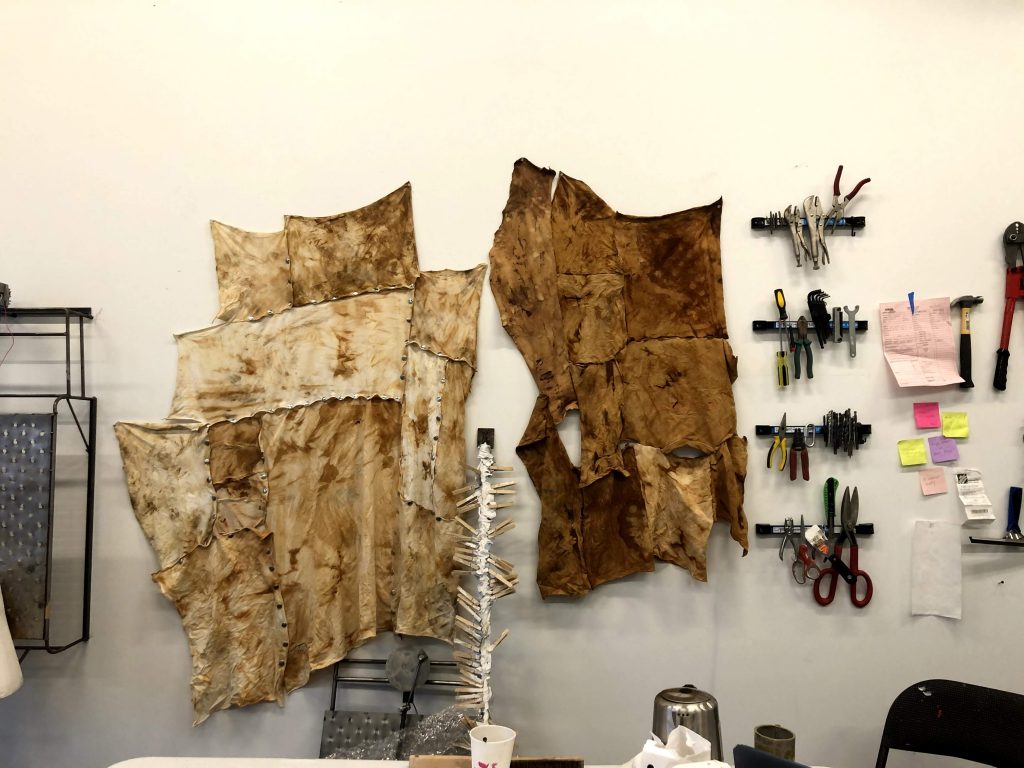
J: Yeah, like a timestamp almost. Yeah so it became about oxidation process how back home how everything rusts–what does that do, how the environment is fighting against these things. It became about this weird conditioning. Also thinking about how this work is about the body, specifically my body, and how I exist in space, how rust isn’t that much different from the process of breathing, you know? Hemoglobin is the protein that binds oxygen to the blood, oxygen and iron, and carries oxygen around the body, and the body needs hemoglobin in order for air to circulate throughout the body. Thinking about how this sterile thing is related, and we have that information right inside of us, and how the process is being enacted on these sculptures and causing them turning brown is also this same process that keeps the blood red–it’s the same process and you think about blood and the taste and smell of blood — it’s actually iron. If you lick a raw piece of iron–it’s the same taste, the same smell and taste.
So now I’m letting the work lead the way and not forcing it because the work knows where it needs to go, where it needs to be. It’s sort of weird how it came back to the body, and breath, and breathing, because a lot of the work I was doing before, during grad school, finishing, was invested in the breath. Something Titus asked me was what my relationship was to water, and in grad school,
I took swimming lessons, and the first exercise you do is bobbing, and that made me highly aware of my breath.
This one is “Mouth to Mouth” and this one is “Out of breath” and the idea behind the sculpture is I’ve been thinking about my relationship to my father, and this is very much a self-portrait of a human trafficker’s son, that was an important index to give way to show how i was thinking about my environment, how i never had a realtionship with my father but one way I think about speaking to him is through my body, my breath. How do I make a breath eternal?
This sculpture is about recycled breath, and became about that one gesture–recycling the plastic but also the breath.
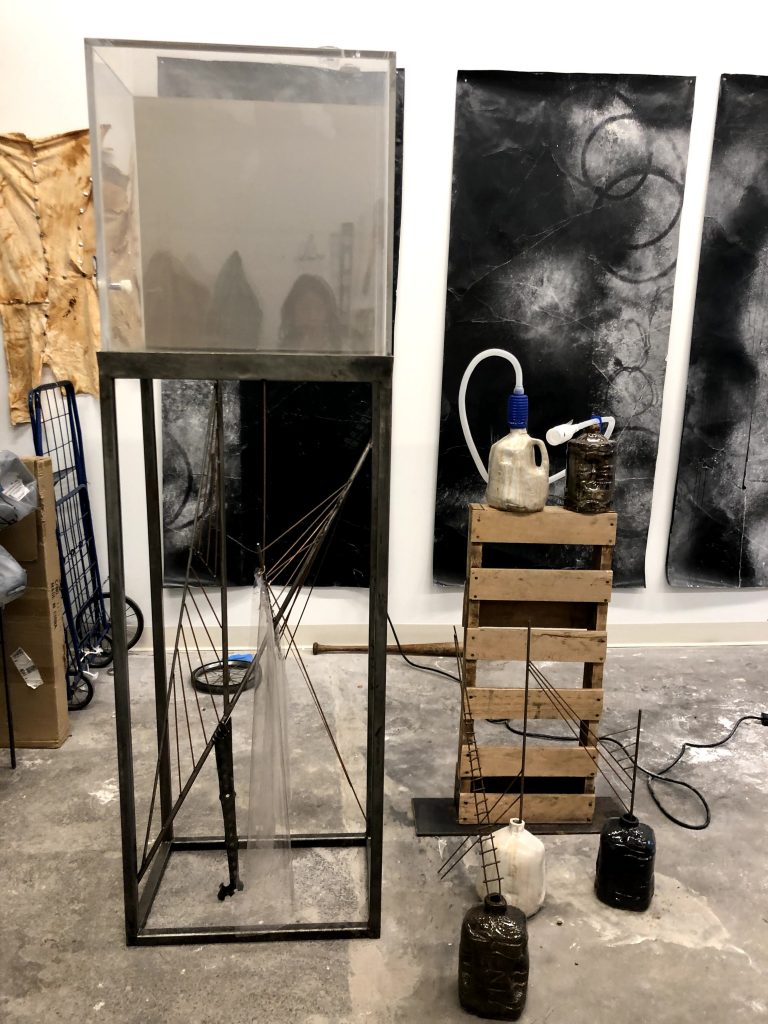
M: That reminds me of a passage in Braiding Sweetgrass, where the breath is being shared between mother and daughter, within a plant, and how this is how we exist in the world, even us right now.
J: The information from our environment, and ancestral information lives inside us.
And then there’s this little guy. And then my little cutie right here! And the sponge comes up in my work quite often because I think of it as a metaphor for immigration, space, borders…
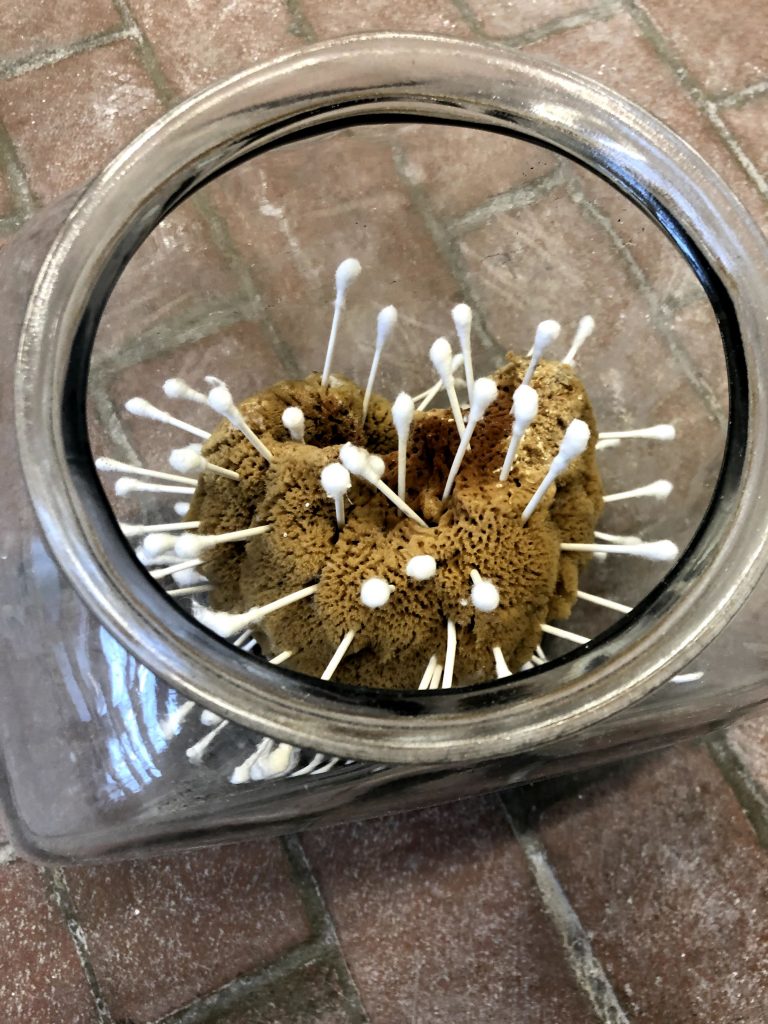
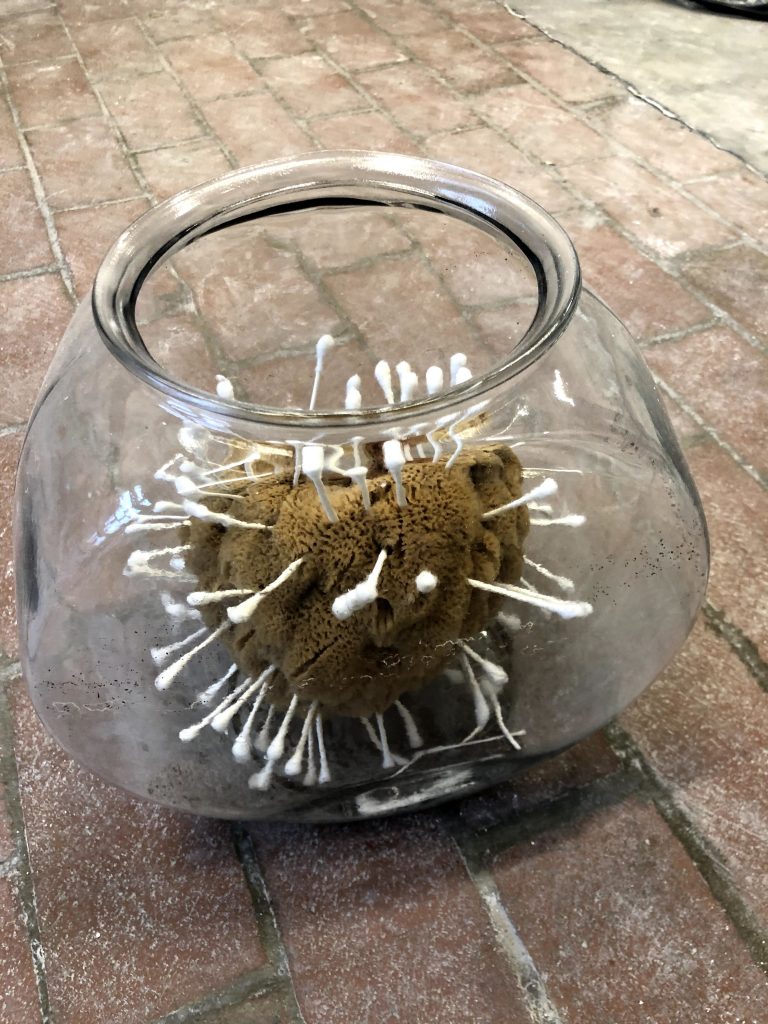
M: Yeah! So porous
J: It’s this social organism, really complex and really simple.
M: Wait. That’s a real sponge? From where?
J: From the Bahamas.
M: [picks up sponge] Oh I thought this was a painter’s sponge. Oh this is wild! It’s so light and delicate!
J: I didn’t know what to do with it. If I should transform it or cut it. Then I realized it’s its own thing. And I could just let it be. Let the material do its thing. [Pours water, dips sponge] It can be just a meaningless gesture, but these Q-tips can also become a silencing mechanism.
M: Something about having your ears plugged where you feel underwater.
J: Exactly. It’s called “Higher Level One” because of the watermark. Going back to the story of these migrants moving through the Bahamas to America. After a while, that sense of movement and space becomes genetic.